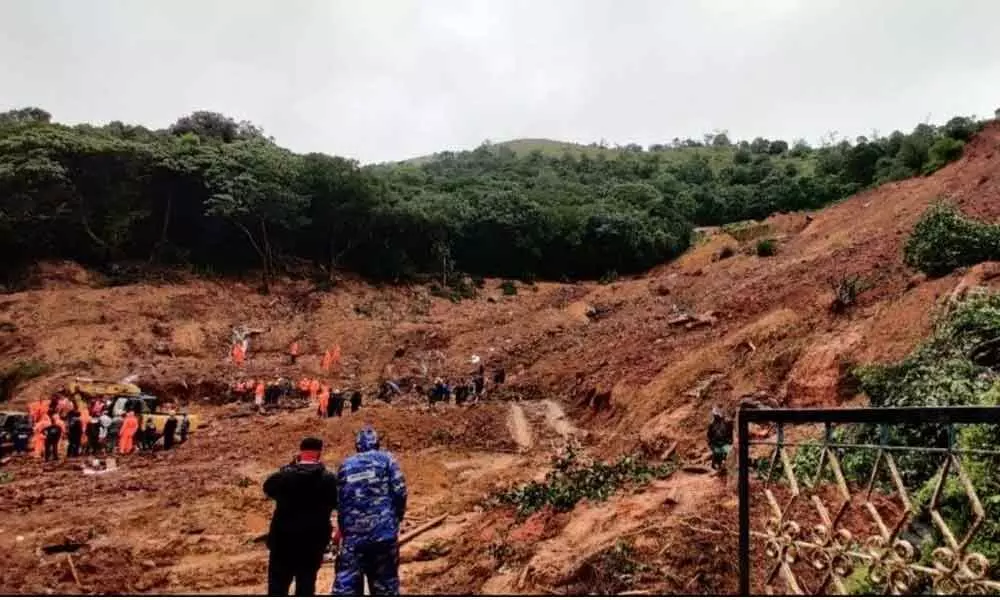GSI Kodagu landslide alarm ignored

GSI Kodagu landslide alarm ignored
The Geological Survey of India (GSI) in its preliminary disaster investigation report on the landslide that occured at Talacauvery in Kodagu district pointed out that the landslide spot had experienced multiple reactivations
Kodagu: The Geological Survey of India (GSI) in its preliminary disaster investigation report on the landslide that occured at Talacauvery in Kodagu district pointed out that the landslide spot had experienced multiple reactivations.
Five persons went missing in collapse of some houses after the landslide in the near Talacauvery following heavy rains and gusty winds, last month.
The GSI report, in possession of The Hans India, states that the landslide spot had experienced multiple reactivations. The GSI, in its report, pointed that three landslides occured in the past. The landslide that occured last month was trigged by human intervention besides changing rain patterns.
This fourth episode of landslide that had occurred in the same spot. The GSI had warned that, at each episode, the landslides were widening. "The landslide spot is unstable and prone to more landslides in the future due to heavy rains," the report stated. The report further states, "Brahmagiri hills, as observed is dissected with road cuts, construction of road, forest trenches, settlements and plantations making the slopes vulnerable.
The vulnerability is thus changed with this change in land use pattern and rainfall pattern in due course of time. The ground cracks and contour trenches observed on the slope acted as pathway for water infiltration of water during heavy rains, which resulted in increased hydrostatic pressure.
This resulted in decreased shear strength of the spot and triggered the reactivation of landslide spot for the fourth time." The GSI made several recommendations on precautionary measures to be taken. Talacauvery is the place from where Cauvery River originates. The Talacauvery Temple holds high religious importance and is a popular tourist spot.
The first landslide occurred on June 30, 2007. Adjacent to this slide, another landslide took place in 2018. "This 2018 slide reactivated and retrograded on 09th August, 2019," the GSI study showed.
Geologists recommended that Talacauvery Temple holds high religious importance and is a popular tourist spot. In view of this, the approach road to the temple should be designed in a way to withstand heavy rains.
"Appropriately designed retaining structures of suitable height with firm foundation are required to be erected from road level for checking slope failure. There should be proper and adequate drainage arrangements in the form of well-designed drains and culverts along the road in order to keep the slope well drained, dry and to avoid the over saturation of the slope forming material which adds to the instability of the slope and in turn to the road," the GSI had recommended.
Further, the GSI also recommended that support should be given at downslope side of the road bench to prevent any road subsidence. Drainage system along the road should be supported by concrete work. Excavation on slope should not be allowed. The excavated slope, if left untreated, is sure to pose threat during heavy rainfall. Any trenches or cracks, if present on the slope should be monitored and filled up with impervious material to restrict any infiltration of water.
"The debris accumulated on the failure surface can be eased by proper benching and planting of deep rooted plants or Vetiver grass. Disrupted drainage pathways should be restored or re-engineered to prevent future water build-up in the slide mass.
The residents living in and around Brahmagiri hills are advised to keep safe distance from the vulnerable slope and vacate the area, especially during heavy or prolonged rainfall," the GSI report stated. District authority should be vigilant during the monsoon period and keep an eye on the rain forecast issued by the meteorological department. It is also suggested to inspect the Brahmagiri hills, once the weather gets clear and any crack or opening should be immediately bring into the notice of authorities, the GSI had suggested.




















